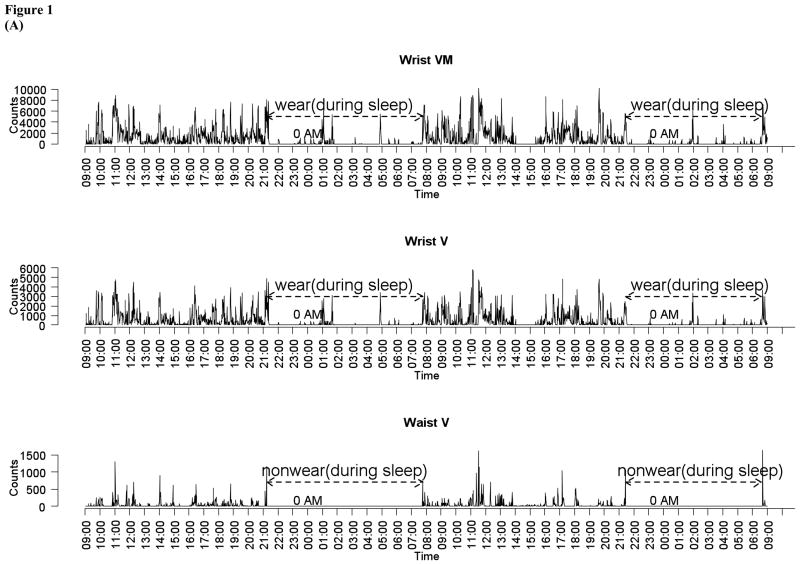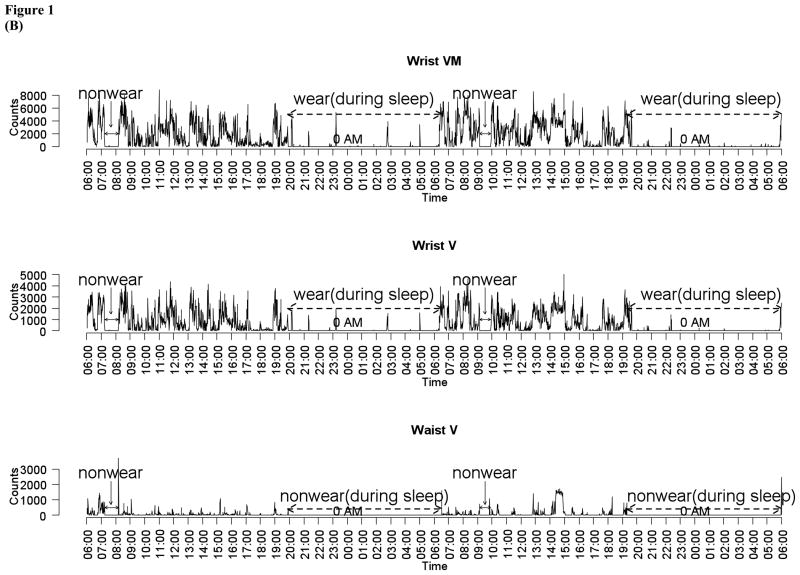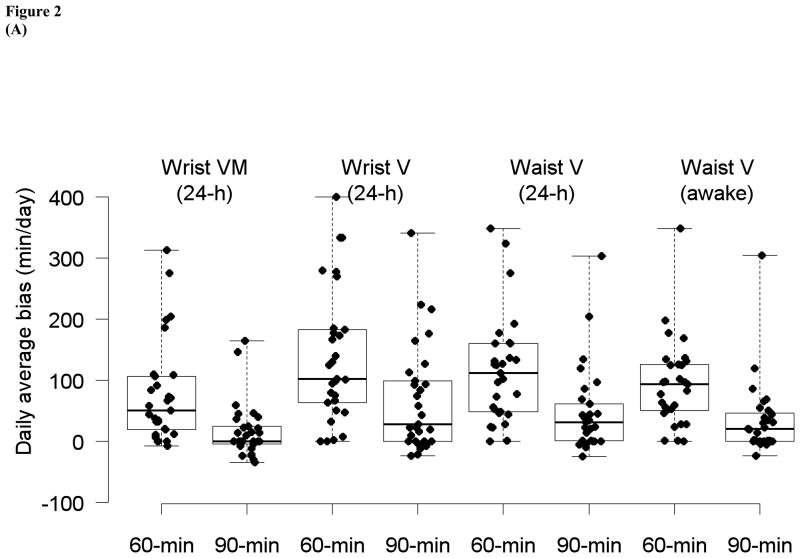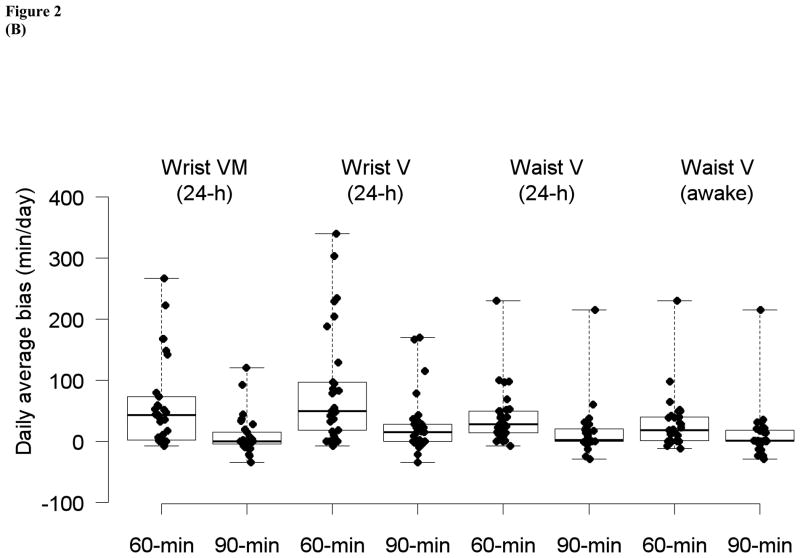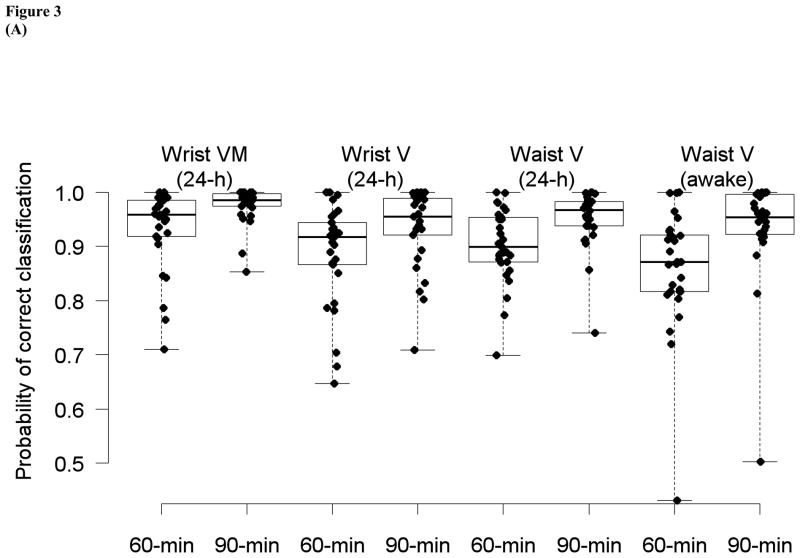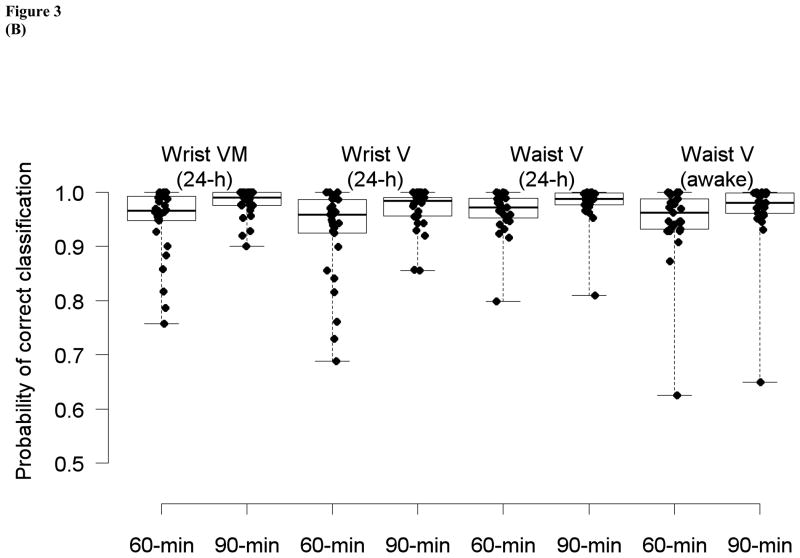Abstract
Purpose
To assess performance of existing wear/nonwear time classification algorithms for accelerometry data collected in the free-living environment using a wrist-worn triaxial accelerometer and a waist-worn uniaxial accelerometer in older adults.
Methods
Twenty-nine adults aged 76 to 96 years wore wrist accelerometers for ~24-h per day and waist accelerometers during waking for ~7 days of free-living. Wear and nonwear times were classified by existing algorithms (Alg[Actilife], Alg[Troiano] and Alg[Choi]) and compared with wear and nonwear times identified by data plots and diary records. Using bias and probability of correct classification, performance of the algorithms, two time-windows (60- and 90-min), and vector magnitude (VM) vs. vertical axis (V) counts from a triaxial accelerometer, were compared.
Results
Automated algorithms (Alg[Choi] and Alg[Troiano]) classified wear/nonwear time intervals more accurately from VM than V counts. The use of 90-min time window improved wear/nonwear classification accuracy when compared with the 60-min window. The Alg[Choi] and Alg[Troiano] performed better than the manufacturer-provided algorithm (Alg[Actilife]), and Alg[Choi] performed better than Alg[Troiano] for wear/nonwear time classification using data collected by both accelerometers.
Conclusions
Triaxial wrist-worn accelerometer can be used for an accurate wear/nonwear time classification in free-living older adults. The use of 90-min window and VM counts improves performance of commonly used algorithms for wear/nonwear classification for both uniaxial and triaxial accelerometers.
Keywords: nonwear categorization, physical activity assessment, accelerometry, sedentary behavior
INTRODUCTION
Lack of physical activity (PA) and a sedentary lifestyle are an important health issue (14) in older adults. In this age group, decreased PA is strongly associated with a higher risk of mortality (9, 13, 15, 17). Among methods used to assess PA in both clinical and epidemiological studies, accelerometry has been frequently used for the measurement of PA, PA-associated energy expenditure, and time spent in various intensity activities (2, 6, 19). Wearable movement monitors such as accelerometers received particular attention since accelerometers offer minimal participant burden, objectivity, versatility, and relative cost efficiency (1, 19).
Accelerometers are commonly worn at the waist using an elastic belt. Data completeness is compromised when the waist monitor is usually detached for bathing, swimming, and sleeping (19), or when the subject forgets to wear the device. Use of small water-resistant accelerometers, worn at wrist without need for intermittent removal, may improve wearing compliance and data completeness. Our earlier studies comparing data from uniaxial accelerometers worn simultaneously at wrist and waist have found, however, that wrist monitors may not capture all body movements (2). Recent technological advances in accelerometry allow longer use of triaxial accelerometers that can detect both anteroposterior and mediolateral movements in addition to the vertical movement typically measured in uniaxial accelerometers (5).
Data collected by accelerometers such as Actigraph in free-living environments are frequently classified to wear and nonwear time intervals. Nonwear time intervals include periods during which participants are asked not to wear their monitor, such as sleeping, showering, and aquatic activities, as well as periods when participants forget to re-attach a monitor. Wear time intervals are the complement of nonwear time intervals, and usually specific hours of wear time (e.g., >10 hours/day) are required for a day to be considered valid (10). Other criteria may include the number of days (e.g., 3 weekdays and 1 weekend day) required for valid PA assessment (18). In addition, the length of wear time is a base for assessing proportions of time spent at various PA intensities (7). Thus, it is critically important to correctly classify wear and nonwear time intervals.
Typically, an automated algorithm uses monitor-specific criteria to detect and eliminate the nonwear time intervals, during which no activity is detected. Distinguishing continuous zero readings due to removal of the accelerometer during certain activities from zero readings due to motionless sitting can be challenging, since participants frequently are still with little movement for periods longer than criteria used by the algorithm (4).
We recently evaluated a commonly used automated algorithm, based on criteria proposed by Troiano et al. (18), to classify wear/nonwear time intervals for the Actigraph GT1M accelerometer and modified it for increased accuracy (4). The improved algorithm is freely available as an R package PhysicalActivity (3), downloadable from http://www.r-project.org/ (12). Both algorithms were originally developed to classify nonwear/wear time for uniaxial accelerometers. To our knowledge, no wear/nonwear classification algorithm for triaxial accelerometers has been developed and validated in older adults. Thus, the primary goal of this study was to assess performance of these two algorithms (termed Alg[Troiano] and Alg[Choi]) with the manufacturer-provided algorithm ActiLife 5 (termed Alg[Actilife]) for triaxial Actigraph GT3X worn at the wrist and uniaxial Actigraph GT1M worn at the waist in free-living older adults. The vertical (V) axis counts from both accelerometers (the two vertical counts are equivalent) and the vector magnitude (VM) calculated from the Actigraph GT3X’s three axes measurements were used to classify wear/nonwear time intervals by all algorithms and the results were compared.
We also evaluated a detection criteria for wear and nonwear classification, which involved time windows of 60-min vs. 90-min; the 60-min is the default time window of Alg[Troiano] and the 90-min is the suggested new default of Alg[Choi] (4). By using an additional monitor worn at waist during waking time only, true accelerometer-wearing status was more accurately identified by comparing the two monitors’ time-aligned data sets. In addition, considering Alg[Troiano] was originally developed to classify wear/nonwear for uniaxial accelerometry data during waking, the performance of each algorithm to classify nonwear/wear time interval for the uniaxial Actigraph data worn at waist during the waking period was also evaluated.
METHODS
Study participants
Twenty-nine older adults (22 females), 76 to 96 years old (86 ± 5) with body weight ranging from 45 to 79 kg (61 ± 8) were recruited from two independent-living facilities that housed approximately 200 residents at the time of the study and one community senior center in Nashville, Tennessee. After hearing a discussion of the project at a group meeting, forty-three older adults volunteered to participate. Most participants who attended the meeting did so because they participated in organized exercise classes (that occurred directly before the meeting). Inclusion criteria included age older than 65-years, English-speaking, able to provide informed self-consent, and able to walk without human assistance. Walking aides were permitted (three participants indicated they used canes or walkers during parts of the day); all participants signed an informed consent approved by the Vanderbilt University Medical Center Institutional Review Board – this partly indicated at least moderate cognitive functioning for most participants. In terms of mobility characteristics, participants’ average self-regulated gait speed over 6 meters was 0.66 m/s (range, 0.25 to 1.09), which was slow, but in normative range of the general elderly population (16). The Fatigue Severity Scale, a standardized interview measure of fatigue, was also administered, and the participants’ mean score was slightly less than the cut-off for indication of chronic fatigue; 39% of participants scored above this cut-off (11), indicating they experienced chronic fatigue that may limit activity (8). Age, mobility, and fatigue characteristics in many individuals were related to low physical activity level. Based on these characteristics we determined that the group was a representative sample of elderly population living in independent living facilities.
Study design and protocol
During the 7-day study in the free-living environment, each participant wore an Actigraph GT3X on a dominant wrist for the entire time (including bedtime) and Actigraph GT1M on the waist at dominant side during waking time. In addition, participants recorded wear and nonwear time in a provided diary.
Data collection
Actigraph data were collected from the summation of the measured accelerations at a 10-s epoch.
Identification of waking period and wear/nonwear status
The waking period and wear/nonwear status were identified by comparing the Actigraph data collected from two monitors worn at wrist and waist and the diary records. For each participant, the ~7 days Actigraph data from both monitors were time-aligned in 1-min epochs, plotted day-by-day with time markers, and compared with diary records. This comparison allowed for an identification of wear/nonwear and sleep/wake periods.
We use the term “sleeping” for periods when waist monitors were not worn as required by the study protocol at night and “waking” for its complement. Sleeping was defined as periods during night hours when no recordings were observed from the waist monitor and little activity from the wrist monitor was detected. During sleeping, wear/nonwear identification was very clear by study design. A typical example is shown in Figure 1 where sleeping is presented by dotted lines. This classification was confirmed by diary records.
Figure 1.
(A) and (B) The first two days of representative data for two subjects who wore wrist monitor for 24-h and waist monitor during waking period: wrist VM (top), wrist V (middle), and waist V (bottom). Wear and nonwear identification during period classified as sleep are represented by dashed arrows. Intervals identified as nonwear during waking are represented by solid arrows in (B).
During the waking period, diary records were in some cases helpful to identify intermittent nonwear time intervals. If a participant recorded that a monitor was taken off for a certain period, Actigraph data from both monitors around that period were more closely plotted with time markers, and identified the exact time of the nonwear intervals. Examples of nonwear time intervals during waking period are shown in Figure 1(B). The complement of nonwear was defined as wear.
Summary statistics and performance outcomes
(1) wearing adherence rate, daily average wear time and bias: Individual wearing-adherence to protocol was calculated by the number of days for which a participant followed protocol (i.e., wearing of wrist monitors for ~24-h and waist monitors for waking period only) divided by total monitoring days. Individual daily average wear time was calculated as a ratio of the sum of the identified wear time and total monitoring days. Individual bias in the daily average wear time was calculated as the difference between the identified and algorithm-derived daily average wear times.
(2) probability of correct classification: Individual probability of correct classification was calculated as a ratio of correctly classified time (min) and total monitoring time (min). Time (min) correctly classified as wear or nonwear was defined as time (min) for which classification by an algorithm agreed with the identified wear/nonwear status.
Assessments of performance
(1) window 60- vs. 90-min: Two parameter settings for time window, 60-min and 90-min, were evaluated for Alg[Troiano] and Alg[Choi] using the bias and the probability of correct classification.
(2) VM vs. V counts: The VM counts from the wrist monitor and the V counts from both wrist and waist monitors were used to classify nonwear/wear time intervals by applying Alg[Troiano] and Alg[Choi], and the performance was compared using the bias and the probability of correct classification.
(3) algorithms: Both the bias in the daily average wear time and the probability of correct classification were used to evaluate the performance of Alg[Troiano] and Alg[Choi]; the bias was used to evaluate Alg[Actilife] due to lack of precise min-by-min classification output from Alg[Actilife].
(4) two sites (wrist vs. waist): The V counts from wrist and waist-worn monitors were compared using the period of data corresponding to waking during which both monitors were worn. The performance of Alg[Troiano] and Alg[Choi] at the two sites were compared at the 60- and the 90-min windows.
Statistical analysis
Wear/nonwear classification was performed using two algorithms based on: 1) wearingMarking function in the R package PhysicalActivity (3) for Alg[Choi], 2) R program in which the 24-h accelerometry data were evaluated without the midnight discontinuation for Alg[Troiano] (4). Data are presented as means and standard deviations (SD), ranges, and/or interquartile range. For each performance outcome measure, Wilcoxon signed-rank test was used to test the difference in performance. The programming language R version 2.10.0 (12) was used for the wear/nonwear classifications and statistical analyses.
RESULTS
Compliance
The number of monitor-wearing days, adherence to protocol (%), daily average wear times (identified and Alg[Actilife]) are summarized in Table 1. Most participants wore the monitors approximately 7 days (the 25th, median and 75th percentiles are 6, 7 and 7 days). The wearing adherence to protocol for wrist and waist monitors were also high (the 25th, median and 75th percentiles are all 100 % for both wrist and waist monitors).
Table 1.
The Number of Monitor Wearing Days, Adherence to Wearing Protocol (%), Identified Daily Average Wear Time during ~24-h and during Both Monitors-Worn Waking Periods (Waist Monitor), Daily Average Wear Time given by Manufacturer-provided Algorithm ActiLife 5 (Alg[Actilife]) and its Bias during ~24-h.
| Identified daily average wear time (min) | Daily average wear time by Alg[Actilife] (min) | Bias in daily average wear time by Alg[Actilife] (min) | Adherence to wearing protocol (%) | Number of days of monitor wearing | ||
|---|---|---|---|---|---|---|
| Wrist | 24-h | 1151 (244) 1110 1250 1318 a, b, c [600 to 1398] |
1031 (259) 824 1115 1253 [560 to 1396] |
120 (156) 11 63 227 [−151 to 593] |
82 (37) 100 100 100 [0 to 100] |
6.4 (1.6) 6 77 [2 to 9] |
| Waist | 24-h | 761 (201) 689 727 790 [275 to 1377] |
632 (189) 542 620 691 [253 to 1139] |
129 (92) 63 117 189 [−38 to 360] |
90 (30) 100 100 100 [0 to 100] |
6.2 (1.5) 6 7 7 [2 to 9] |
| awake | 702 (117) 653 720 755 [275 to 953] |
__ | __ |
a – 25th percentile; b – 50th percentile (median); c – 75th percentile.
Values are means (SD), medians, 25th and 75th percentiles; ranges are in square brackets.
— : data are not available.
The daily average wear time for the wrist monitor was close to 1440 min/day (the 25th, median and 75th percentiles are 1110, 1250 and 1318), indicating that most participants wore the wrist monitors ~24-h most days except the first and last days (because they started wearing monitors in the middle of the first day and often removed them before the midnight of the last day). The medians of the daily average wear time for the waist monitor during 24-h and waking periods were 727 and 720 minutes, respectively, suggesting good adherence to the protocol.
Classification bias and correct classification probability
The classification bias by Alg[Actilife] is summarized in Table 1. The classification bias and probability of correct classification from wrist (VM and V) and waist (V) monitor data by Alg[Troiano] and Alg[Choi] using 60- and 90-min window are summarized in Table 2 and their individual data are presented in Figures 2 and 3. The smaller classification bias and the greater correct classification probability are considered as a better performance.
Table 2.
Bias (Identified – Classified), Probability of Correct Classification by Algorithms (Alg[Troiano] and Alg[Choi]) with Window 60-min and 90-min during ~24-h and during Both Monitors-Worn Waking Periods (Waist Monitor).
| Bias (min) | Probability of correct classification | ||||||
|---|---|---|---|---|---|---|---|
| 60-min | 90-min | 60-min | 90-min | ||||
| Wrist | VM | 24-h | Alg[Troiano] | 77 (84) 19 50 106 a, b, c [−8 to 313] |
17 (45) −4 025 [−34 to 165] |
0.93 (0.07) 0.92 0.96 0.99 [0.71 to 1.00] |
0.98 (0.03) 0.97 0.99 1.00 [0.85 to 1.00] |
| Alg[Choi] | 61 (73) 2 43 73 [−8 to 267] |
10 (32) −4 0 15 [−34 to 120] |
0.95 (0.07) 0.95 0.97 0.99 [0.76 to 1.00] |
0.98 (0.03) 0.980.99 1.00 [0.90 to 1.00] |
|||
| V | 24-h | Alg[Troiano] | 138 (110) 63 102 183 [0 to 400] |
67 (88) 0 28 99 [−24 to 341] |
0.89 (0.09) 0.87 0.92 0.94 [0.65 to 1.00] |
0.94 (0.07) 0.92 0.95 0.99 [0.71 to 1.00] |
|
| Alg[Choi] | 87 (94) 18 49 97 [−8 to 340] |
27 (49) 0 15 28 [−34 to 170] |
0.93 (0.08) 0.93 0.96 0.99 [0.69 to 1.00] |
0.97 (0.04) 0.96 0.98 0.99 [0.86 to 1.00] |
|||
| Waist V | 24-h | Alg[Troiano] | 116 (88) 48 112 160 [0 to 349] |
48 (70) 1 31 61 [−25 to 304] |
0.90 (0.07) 0.87 0.90 0.95 [0.70 to 1.00] |
0.95 (0.05) 0.94 0.97 0.98 [0.74 to 1.00] |
|
| Alg[Choi] | 40 (47) 14 28 49 [−8 to 230] |
16 (42) 0 2 20 [−29 to 215] |
0.96 (0.04) 0.95 0.97 0.99 [0.80 to 1.00] |
0.98 (0.04) 0.98 0.99 1.00 [0.81 to 1.00] |
|||
| awake | Alg[Troiano] | 97 (73) 53 83 131 [0 to 349] |
36 (62) 0 20 46 [−25 to 305] |
0.86 (0.11) 0.82 0.870.92 [0.43 to 1.00] |
0.94 (0.09) 0.92 0.95 1.00 [0.5 to 1.00] |
||
| Alg[Choi] | 32 (47) 2 18 40 [−12 to 230] |
12 (43) 0 1 18 [−29 to 215] |
0.95 (0.07) 0.93 0.96 0.99 [0.62 to 1.00] |
0.97 (0.06) 0.96 0.98 1.00 [0.65 to 1.00] |
|||
a – 25th percentile; b – 50th percentile (median); c – 75th percentile.
Values are means (SD), medians, 25th and 75th percentiles; ranges are in square brackets.
V- vertical axis (single); VM - vector magnitude of 3 axes (vertical, horizontal, 3rd) calculated as VM = √x2 + y2 + z2, where x, y and z are the measurements from the 3 axes.
Figure 2.
Box plots of individual bias in the daily average wear time (identified - classified) (min) classified by algorithms with two window time settings (60- and 90-min) using wrist (VM and V) and waist (V) counts data during 24-h and both monitors-worn waking periods: (A) Alg[Troiano]; (B) Alg[Choi]. The solid circles represent individual data points (N=29).
Figure 3.
Box plots of individual probability of correct classification by algorithms with two window time settings (60- and 90-min) using wrist (VM and V) and waist (V) counts data during 24-h and both monitors-worn waking periods: (A) Alg[Troiano]; (B) Alg[Choi]. The solid circles represent individual data points (N=29).
(1) Comparison between 60-min and 90-min window: The performance of both algorithms using the 90-min window was better than that using the 60-min window for both wrist (VM and V) and waist (V) monitor data (all P < 0.05). For the wrist VM data, the 90-min window, when compared to the 60-min window, reduced the mean bias from 77 to 17 min for Alg[Troiano] and from 61 to 10 min for Alg[Choi]. For the wrist V counts, the mean bias reduction was from 138 to 67 min for Alg[Troiano] and from 87 to 27 min for Alg[Choi]. For the waist V counts, the mean bias reduction was from 116 to 48 min for Alg[Troiano] and from 40 to 16 min for Alg[Choi]. For the waist V counts during waking, the 90-min window reduced the mean bias more for Alg[Troiano] than Alg[Choi] (97 to 36 min and 32 to 12 min, respectively). In terms of the correct classification probability, a similar improvement in the performance was observed. For example, the 90-min window increased the mean correct classification probability by the Alg[Troiano] from 0.93 to 0.98 for the wrist VM counts and from 0.90 to 0.95 for the waist V counts. Similarly, the mean probability increases by Alg[Choi] were from 0.95 to 0.98 and from 0.96 to 0.98 for the wrist VM and the waist V counts, respectively. Overall, the 90-min window improved Alg[Troiano] more than Alg[Choi] for both wrist and waist monitors. Moreover, the 90-min reduced the variability in both individual mean biases and correct classification probabilities compared to the 60-min window (see Figures 2 and 3).
(2) Comparison between V and VM counts: For both 60- and 90-min window time settings, the VM counts were more sensitive in detecting movement and hence performed better than the V counts (all P < 0.05). Compared to the V counts, the use of VM counts reduced mean bias of Alg[Troiano] by 61 and 50 minutes for the 60- and 90-min window, respectively. Corresponding reduction in mean bias of a better performing Alg[Choi] were 26 and 17 minutes, respectively. The VM counts generated similar improvements in thecorrect classification probability for both Alg[Troiano] and Alg[Choi] (Table 2 and Figure 3).
(3) Comparison between algorithms: Wear times calculated using the VM (wrist monitor) and the V (waist monitor) counts by Alg[Actilife] were significantly underestimated compared to Alg[Troiano] and Alg[Choi] with 90-min window (P < 0.05). The mean biases of Alg[Actilife] vs. Alg[Troiano] vs. Alg[Choi] were 120 vs. 17 vs. 10 min for wrist, 129 vs. 48 vs. 16 min for waist data with 90-min window. The bias of Alg[Choi] was smaller than Alg[Troiano] for all comparisons (P < 0.05). The probabilities of correct classification by Alg[Choi] were greater than those by Alg[Troiano] (P < 0.05 for all comparisons except P = 0.104 for the best combination of using the VM counts and the 90-min window).
(4) Comparison between two sites: Wear times classified from the waist data subset to both monitors-worn waking period were significantly underestimated compared with wrist data using both Alg[Troiano] vs. Alg[Choi] with 60- and 90-min windows (all P < 0.05). The mean biases from waist (V) and wrist (V) were 94 vs. 10 min using Alg[Troiano], and 30 vs. 8 min using Alg[Choi] with 60-min window, while 35 vs. 1 min and 12 vs. 0 min with 90-min window. The probabilities of correct classification by wrist monitor were also greater than those by waist using both algorithms with both window settings (all P < 0.05).
DISCUSSION
We evaluated performance of the wear/nonwear time interval classification algorithms for accelerometry data collected under the free-living environment using a triaxial accelerometer worn at wrist for 24 hours per day and a uniaxial accelerometer worn at waist during waking in older adults for ~7 days. These two approaches are the most commonly used in clinical and population-based studies. Benefits of using small water-resistant wrist-worn monitor for 24 hours are a decreased burden to participant and reduced uncertainty about protocol adherence. In our approach, we considered that the wrist monitor was worn for 24 hours unless a nonwear was identified in the diary or plots. A majority of study participants (23 out of 29) wore the wrist monitor for 24 hours per day and 26 out of 29 participants adhered to the waist-worn monitor protocol. The study design allowed us to identify accurately nonwear/wear status by comparing simultaneously collected and time-aligned data (counts) from both monitors. The minute-by-minute plots generated from these data were aligned with the diary records for monitor wear/nonwear confirmation. Thus, we considered biases and correct classification probabilities as appropriate measures for the performance assessment.
There are several findings from this study. First, wearing a wrist monitor for 24 hours is feasible and well tolerated in older adults. Second, the VM counts measure was more sensitive in classifying wear/nonwear compared to the V counts. This could be especially useful for correct classification of sedentary behaviors as wear time. Third, the results confirm our previous finding (4) that, compared with the 60-min, the 90-min window decreases misclassification is applicable also to older adults. This is especially important in a population with a sedentary lifestyle, such as the elderly, since a longer time-window setting would prevent sedentary behaviors from being misclassified as nonwear. Fourth, the manufacturer-provided algorithm (Alg[Actilife]) significantly underestimated the wear time and performed worse than both Alg[Troiano] and Alg[Choi], whereas Alg[Choi] performed better when compared to Alg[Troiano]. Fifth, a monitor worn at wrist was more sensitive in detecting wear/nonwear compared to the waist-worn monitor. The wearing schedule for wrist and waist monitors differed by design; thus for the site comparison we examined only both monitors-worn waking period data. The results revealed that, in our study population, the waist monitor is more biased than the wrist monitor in wear-time classification. We speculate that the bias would be even higher if the sleeping/bedtime was included in the analysis. Finally, the performance of Alg[Troiano] was significantly improved by using VM counts and by increasing the current default 60-min to the 90-min window. As a result, the difference in classification bias between Alg[Troiano] and Alg[Choi] decreased. The plausible explanation is that using both VM counts and 90-min window reduced frequent misclassification of sedentary periods by Alg[Troiano] as nonwear. Further improvement of the Alg[Troiano] in sedentary older adults could be achieved by reducing the originally proposed 100 counts/minute nonwear threshold (4, 21).
Practical and clinical implications of this study include improvement in correct classification of time spent in various PA intensities and thus, improvement in assessment of the association of PA with health or quality of life outcomes. Although each daily bias may be small, it would accumulate over time and thus its precise classification is important. For example, misclassification of wear during sedentary activity as nonwear could overestimate a relative time spent in light and moderate activity intensities and energy spent in PA. This misclassification could be clinically important when assessing health risks associated with PA in older adults who spend vast majority of their waking time in sedentary behaviors.
Initial data analysis revealed several outliers with substantial bias and/or low probability of correct classification. The results were greatly improved to a reasonable range by using VM, 90-min window, and Alg[Choi], except two subjects with bias > 100 min. The two participants (88-year old female and 90-year old male) had unusual behavior patterns difficult for an automated algorithm to process. Their sleep pattern was very unusual and their daily activities were mostly sedentary with several intervals characteristic to sleep/bedtime regularly appearing during day times (likely naps). Some of the intervals were longer than 90-min window and consequently classified as nonwear resulting in a bias > 100 min/day. Thus, although the suggested algorithms may work well for the majority of elderly population, researchers should use caution when analyzing data from individuals with unusual sleep pattern and/or exceptionally sedentary behavior.
Our study has some limitations. First, some identification of wear/nonwear status might not be correct. This error could be caused by a short-time detachment of a monitor (e.g., for showering) without recording the event in the diary. Considering excellent compliance and the total wear-time duration in the free-living environment (~10,000 minutes), this error could be considered small. Nevertheless, to examine sensitivity of methods to identification of wear/nonwear, we used wrist (n=27) and waist (n=23) data for which diary records were available for most days, and compared identification of wear/nonwear times using diary records and monitor data records separately. The identified daily average wear times were not significantly different (P > 0.05) between the two methods; their differences were −5 ± 16 min ranging from −61 to 32 for the wrist and −1 ± 26 min ranging from −42 to 54 for the waist. We found that diary records were in some cases helpful in identifying short nonwear intervals during waking, whereas monitor data records were more accurate in identifying monitor on and off times, since most subjects recorded approximated times rather than exact (e.g., 7:30 AM for 7:21 AM). Thus, although our results from this study would not be sensitive to the methods of wear/nonwear identification, our method of using both diary and monitor data information in identifying wear/nonwear would provide more accurate results. We acknowledge that an optimal experimental design would be a study with supervised nonwear intervals, but such study would be difficult if not impossible to conduct in a free-living elderly population.
Second, since the wrist accelerometer data did not contain many true nonwear intervals, their classification was not extensively evaluated. As discussed by Van Domelen et al. (20), a larger time-window (e.g. 90-min) may increase misclassification of short nonwear periods (≤ 90 min) as wear time. This is a trade-off between two types of misclassifications; thus, the choice of window should depend on error rates caused by the algorithm. The results of this and our previous study (4) suggest that the error rate from misclassification of nonwear as wear is less than that from misclassification of wear as nonwear intervals. This notion is supported by the data showing that, in older adults, time spent in sedentary behaviors is much greater than relatively short periods when a monitor is removed. As technology advances, more sensitive accelerometers will be developed that will detect very small movements, and then a smaller window may be used to decrease the second type of error while still keeping the first type of error small.
Lastly, our study was conducted in sedentary older adults, limiting generalization of the results to younger populations. We anticipate that the algorithms with suggested criteria will perform with at least as or more accuracy in populations with higher physical activity levels.
In conclusion, both Alg[Troiano] and Alg[Choi] classified nonwear/wear time intervals of triaxial wrist-worn monitor more accurately from the VM than from the V counts. We recommend using a 90-min window for both algorithms to classify nonwear/wear time intervals for both a triaxial wrist-worn and a uniaxial waist-worn accelerometer data in free-living older adults. Overall, Alg[Choi] performed better for classification of nonwear/wear time interval compared to Alg[Troiano] and both performed better than Alg[Actilife] which significantly underestimated wear time. We recommend that monitor manufacturers and software developers work with researchers to improve algorithm performance in diverse populations.
Acknowledgments
We acknowledge the contribution of Lauren Whitaker from the Clinical Research Center, and Shannon Pottmeyer and Daniel W. Durkin from the Center of Quality Aging. We thank Peggy Schuyler for editorial help.
This study was supported in part by R01 DK69465 from NIDDK/NIH, Vanderbilt CTSA grant 1UL1 RR024975 from NCRR/NIH, and Vanderbilt Diabetes Research and Training Center grant DK020593 from NIDDK/NIH.
The results of the present study do not constitute endorsement by American College of Sports Medicine.
Footnotes
Conflict of Interest: none.
References
- 1.Bassett DR, Jr, Rowlands A, Trost SG. Calibration and validation of wearable monitors. Med Sci Sports Exerc. 2012;44(1 Suppl 1):S32–8. doi: 10.1249/MSS.0b013e3182399cf7. [DOI] [PMC free article] [PubMed] [Google Scholar]
- 2.Buchowski MS, Acra S, Majchrzak KM, Sun M, Chen KY. Patterns of physical activity in free-living adults in the southern united states. Eur J Clin Nutr. 2007;58(5):828–37. doi: 10.1038/sj.ejcn.1601928. [DOI] [PubMed] [Google Scholar]
- 3.Choi L, Liu Z, Matthews CE, Buchowski MS. Physicalactivity: Process physical activity accelerometer data. 2010:1–14. [Google Scholar]
- 4.Choi L, Liu Z, Matthews CE, Buchowski MS. Validation of accelerometer wear and nonwear time classification algorithm. Med Sci Sports Exerc. 2011;43(2):357–64. doi: 10.1249/MSS.0b013e3181ed61a3. [DOI] [PMC free article] [PubMed] [Google Scholar]
- 5.Freedson P, Bowles HR, Troiano R, Haskell W. Assessment of physical activity using wearable monitors: Recommendations for monitor calibration and use in the field. Med Sci Sports Exerc. 2012;44(1 Suppl 1):S1–4. doi: 10.1249/MSS.0b013e3182399b7e. [DOI] [PMC free article] [PubMed] [Google Scholar]
- 6.Hagstromer M, Oja P, Sjostrom M. Physical activity and inactivity in an adult population assessed by accelerometry. Med Sci Sports Exerc. 2007;39(9):1502–8. doi: 10.1249/mss.0b013e3180a76de5. [DOI] [PubMed] [Google Scholar]
- 7.Healy GN, Clark BK, Winkler EA, Gardiner PA, Brown WJ, Matthews CE. Measurement of adults’ sedentary time in population-based studies. Am J Prev Med. 2011;41(2):216–27. doi: 10.1016/j.amepre.2011.05.005. [DOI] [PMC free article] [PubMed] [Google Scholar]
- 8.Herlofson K, Larsen JP. Measuring fatigue in patients with parkinson’s disease - the fatigue severity scale. Eur J Neurol. 2002;9(6):595–600. doi: 10.1046/j.1468-1331.2002.00444.x. [DOI] [PubMed] [Google Scholar]
- 9.Manini TM, Everhart JE, Patel KV, Schoeller DA, Colbert LH, Visser M, et al. Daily activity energy expenditure and mortality among older adults. JAMA. 2006;296(2):171–9. doi: 10.1001/jama.296.2.171. [DOI] [PubMed] [Google Scholar]
- 10.Matthews CE, Chen KY, Freedson PS, Buchowski MS, Beech BM, Pate RR, et al. Amount of time spent in sedentary behaviors in the united states, 2003–2004. Am J Epidemiol. 2008;167(7):875–81. doi: 10.1093/aje/kwm390. [DOI] [PMC free article] [PubMed] [Google Scholar]
- 11.Min L, Yoon W, Mariano J, Wenger NS, Elliott MN, Kamberg C, et al. The vulnerable elders-13 survey predicts 5-year functional decline and mortality outcomes in older ambulatory care patients. J Am Geriatr Soc. 2009;57(11):2070–6. doi: 10.1111/j.1532-5415.2009.02497.x. [DOI] [PMC free article] [PubMed] [Google Scholar]
- 12.R Development Core Team. R: A language and environment for statistical computing. Vienna, Austria: 2009. pp. 1–1820. [Google Scholar]
- 13.Sattelmair JR, Pertman JH, Forman DE. Effects of physical activity on cardiovascular and noncardiovascular outcomes in older adults. Clinics in Geriatric Medicine. 2009;25(4):677–702. doi: 10.1016/j.cger.2009.07.004. [DOI] [PubMed] [Google Scholar]
- 14.Sondik EJ, Huang DT, Klein RJ, Satcher D. Progress toward the healthy people 2010 goals and objectives. Annu Rev Public Health. 2010;31:271–81. doi: 10.1146/annurev.publhealth.012809.103613. [DOI] [PubMed] [Google Scholar]
- 15.Stessman J, Hammerman-Rozenberg R, Cohen A, Ein-Mor E, Jacobs JM. Physical activity, function, and longevity among the very old. Arch Intern Med. 2009;169(16):1476–83. doi: 10.1001/archinternmed.2009.248. [DOI] [PubMed] [Google Scholar]
- 16.Studenski S, Perera S, Patel K, Rosano C, Faulkner K, Inzitari M, et al. Gait speed and survival in older adults. JAMA. 2011;305(1):50–8. doi: 10.1001/jama.2010.1923. [DOI] [PMC free article] [PubMed] [Google Scholar]
- 17.Talbot LA, Morrell CH, Fleg JL, Metter EJ. Changes in leisure time physical activity and risk of all-cause mortality in men and women: The Baltimore longitudinal study of aging. Preventive Medicine. 2007;45(2–3):169–76. doi: 10.1016/j.ypmed.2007.05.014. [DOI] [PubMed] [Google Scholar]
- 18.Troiano RP, Berrigan D, Dodd KW, Masse LC, Tilert T, McDowell M. Physical activity in the united states measured by accelerometer. Med Sci Sports Exerc. 2008;40(1):181–8. doi: 10.1249/mss.0b013e31815a51b3. [DOI] [PubMed] [Google Scholar]
- 19.Trost SG, McIver KL, Pate RR. Conducting accelerometer-based activity assessments in field-based research. Med Sci Sports Exerc. 2005;37(11 Supplement):S531–S43. doi: 10.1249/01.mss.0000185657.86065.98. [DOI] [PubMed] [Google Scholar]
- 20.Van Domelen DR, Koster A, Harris TB. Accelerometer nonwear algorithms: Optimizing parameters for both wear states. Med Sci Sports Exerc. 2011;43(5):932. doi: 10.1249/MSS.0b013e318212b002. author reply 933. [DOI] [PubMed] [Google Scholar]
- 21.Winkler EA, Gardiner PA, Clark BK, Matthews CE, Owen N, Healy GN. Identifying sedentary time using automated estimates of accelerometer wear time. Br J Sports Med. 2011 Apr 18; doi: 10.1136/bjsm.2010.079699. [Epub ahead of print] [DOI] [PMC free article] [PubMed] [Google Scholar]



